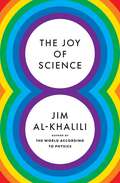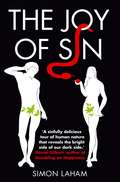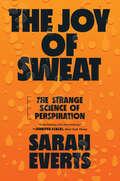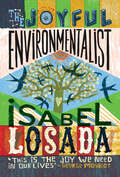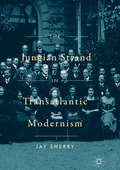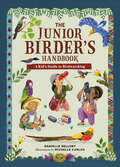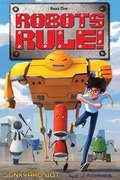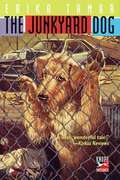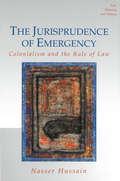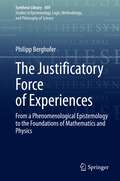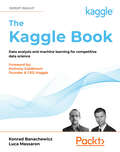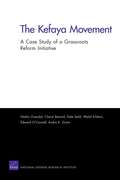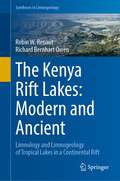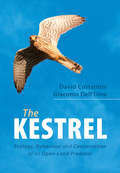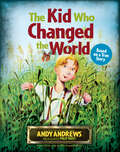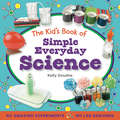- Table View
- List View
The Joy of Science
by Roel Snieder Jen SchneiderWe live in an age where working in science or engineering offers tremendous professional opportunities - the pace of scientific development is truly breathtaking. Yet many researchers struggle with the pressures of the fast-paced academic workplace, and struggle to harmonize their work and personal lives. The result can be burnout, exhaustion, and stress on a personal level, and difficulty in recruiting and retaining talented, diverse people to science and engineering. This book, written for graduate students and researchers at all stages of their careers, aims to help scientists by identifying and questioning the core beliefs that drive a culture of overwork, and provides real-world examples and exercises for those wishing to do things differently. Written in a lively narrative style, and including interview excerpts from practicing scientists, social scientists, and engineers, this book serves as a guide for those seeking to practice the seven traits of the joyful scientist.
The Joy of Science
by Jim Al-KhaliliQuantum physicist, New York Times bestselling author, and BBC host Jim Al-Khalili reveals how 8 lessons from the heart of science can help you get the most out of lifeToday’s world is unpredictable and full of contradictions, and navigating its complexities while trying to make the best decisions is far from easy. The Joy of Science presents 8 short lessons on how to unlock the clarity, empowerment, and joy of thinking and living a little more scientifically.In this brief guide to leading a more rational life, acclaimed physicist Jim Al-Khalili invites readers to engage with the world as scientists have been trained to do. The scientific method has served humankind well in its quest to see things as they really are, and underpinning the scientific method are core principles that can help us all navigate modern life more confidently. Discussing the nature of truth and uncertainty, the role of doubt, the pros and cons of simplification, the value of guarding against bias, the importance of evidence-based thinking, and more, Al-Khalili shows how the powerful ideas at the heart of the scientific method are deeply relevant to the complicated times we live in and the difficult choices we make.Read this book and discover the joy of science. It will empower you to think more objectively, see through the fog of your own preexisting beliefs, and lead a more fulfilling life.
The Joy of Secularism: 11 Essays for How We Live Now
by George LevineCan secularism offer us moral, aesthetic, and spiritual satisfaction? Or does the secular view simply affirm a dog-eat-dog universe? At a time when the issues of religion, evolution, atheism, fundamentalism, Darwin, and science fill headlines and invoke controversy, The Joy of Secularism provides a balanced and thoughtful approach for understanding an enlightened, sympathetic, and relevant secularism for our lives today. Bringing together distinguished historians, philosophers, scientists, and writers, this book shows that secularism is not a mere denial of religion. Rather, this positive and necessary condition presents a vision of a natural and difficult world--without miracles or supernatural interventions--that is far richer and more satisfying than the religious one beyond. From various perspectives--philosophy, evolutionary biology, primate study, Darwinian thinking, poetry, and even bird-watching--the essays in this collection examine the wealth of possibilities that secularism offers for achieving a condition of fullness. Factoring in historical contexts, and ethical and emotional challenges, the contributors make an honest and heartfelt yet rigorous case for the secular view by focusing attention on aspects of ordinary life normally associated with religion, such as the desire for meaning, justice, spirituality, and wonder. Demonstrating that a world of secular enchantment is a place worth living in, The Joy of Secularism takes a new and liberating look at a valuable and complex subject. The contributors are William Connolly, Paolo Costa, Frans de Waal, Philip Kitcher, George Levine, Adam Phillips, Robert Richards, Bruce Robbins, Rebecca Stott, Charles Taylor, and David Sloan Wilson.
The Joy of Sin: The Psychology of the Seven Deadly Sins
by Simon LahamUsing modern psychological science, a great deal of research, historical anecdotes and an eloquent turn of phrase, the author contends that the 'seven deadly sins' not only feel good, but are also good for you. From gluttony to greed, to envy and lust, even the deadliest of sins can make you smart, successful and happy. For example, anger can breed perseverance, sloth: hopefulness, greed: happiness and envy can actually bolster one's self-esteem. Based on many studies, the author tells us why the greedy are happy, the slothful are smart, gluttons are social butterflies and how anger can make you a fearsome negotiator.The simplistic labelling of the seven deadly sins as 'sins' or as uniformly wrong does nothing but breed contempt for 'sinners' and stifle sophisticated discussion. Sin rails against this simplicity. Each chapter will cover an array of fascinating psychological research that demonstrates just how interesting and complex the seven deadly sins are. So the basic message of Sin: relax, spend, eat, drink and generally covet - you'll be better off for it.
The Joy of Sweat: The Strange Science Of Perspiration
by Sarah EvertsA New York Times Most Anticipated Book of the Summer A taboo-busting romp through the shame, stink, and strange science of sweating. Sweating may be one of our weirdest biological functions, but it’s also one of our most vital and least understood. In The Joy of Sweat, Sarah Everts delves into its role in the body—and in human history. Why is sweat salty? Why do we sweat when stressed? Why do some people produce colorful sweat? And should you worry about Big Brother tracking the hundreds of molecules that leak out in your sweat—not just the stinky ones or alleged pheromones—but the ones that reveal secrets about your health and vices? Everts’s entertaining investigation takes readers around the world—from Moscow, where she participates in a dating event in which people sniff sweat in search of love, to New Jersey, where companies hire trained armpit sniffers to assess the efficacy of their anti-sweat products. In Finland, Everts explores the delights of the legendary smoke sauna and the purported health benefits of good sweat, while in the Netherlands she slips into the sauna theater scene, replete with costumes, special effects, and towel dancing. Along the way, Everts traces humanity’s long quest to control sweat, culminating in the multibillion-dollar industry for deodorants and antiperspirants. And she shows that while sweating can be annoying, our sophisticated temperature control strategy is one of humanity’s most powerful biological traits. Deeply researched and written with great zest, The Joy of Sweat is a fresh take on a gross but engrossing fact of human life.
The Joyful Environmentalist (Revised and Updated 2nd Edition with New Material): How to Practise without Preaching
by Isabel LosadaFully updated and revised edition of Isabel Losada's highly endorsed, feel good guide to how we all need to live now and how it will enrich our lives. Accessible, funny and practical steps to saving the planet that will encourage readers to take action.Finally! A book about saving our planet that is fast, funny and inspiring too. Written in short chapters for busy people, Isabel doesn&’t bother with an examination of the problem but gets right on with the solutions. Her aim: to look for every single way we can take care of the planet; how we live and work, travel, shop, eat, drink, dress, vote, play, volunteer, bank – everything. And to do this wholeheartedly, energetically and joyfully.Beginning with losing her cool in a restaurant that will only provide plastic cutlery, Isabel journeys through native tree planting in the Highlands of Scotland, playing Samba drums with Extinction Rebellion, interviewing in person the people that supply her energy and food – through every solution she can find – until both narrator and reader are fully equipped to be part of the pollution solution."She gave my spirit a lift and my feet somewhere to stand." – Sir Mark Rylance
The Juggler's Children
by Carolyn AbrahamCarolyn Abraham explores the stunning power and ethical pitfalls of using genetic tests to answer questions of genealogy--by cracking the genome of her own family. Recently, tens of thousands of people have been drawn to mail-order DNA tests to learn about their family roots. Abraham investigates whether this burgeoning new science can help solve 2 mysteries that have haunted her multi-racial family for more than a century. Both hinge on her enigmatic great-grandfathers--a hero who died young and a scoundrel who disappeared. Can the DNA they left behind reveal their stories from beyond the grave? Armed with DNA kits, Abraham criss-crosses the globe, taking cells from relatives and strangers, a genetic journey that turns up far more than she bargained for--ugly truths and moral quandaries. With lively writing and a compelling personal narrative, The Juggler's Children tackles profound questions around the genetics of identity, race and humanity, and tells a big story about our small world, with vivid proof that genes bind us all to the branches of one family tree.From the Hardcover edition.
The Jungian Strand in Transatlantic Modernism
by Jay SherryIn studies of psychology’s role in modernism, Carl Jung is usually relegated to a cameo appearance, if he appears at all. This book rethinks his place in modernist culture during its formative years, mapping Jung’s influence on a surprisingly vast transatlantic network of artists, writers, and thinkers. Jay Sherry sheds light on how this network grew and how Jung applied his unique view of the image-making capacity of the psyche to interpret such modernist icons as James Joyce and Pablo Picasso. His ambition to bridge the divide between the natural and human sciences resulted in a body of work that attracted a cohort of feminists and progressives involved in modern art, early childhood education, dance, and theater.
The Junior Birder's Handbook: A Kid's Guide to Birdwatching (The Junior Handbook Series)
by Danielle BellenyA beautifully illustrated kid's guide to birds and their habitats, perfect for budding birders whether you live in a city, suburb, or rural area. In the woods, in cities, in your backyard—birds are everywhere. But do you know the difference between a robin and a wren? A raven and a crow? In this fully illustrated book, you will learn how to identify birds in an array of habitats and seasons (thanks to migration, there are always new birds to find). You'll also learn the different behaviors/habits of birds—from why blue jays divebomb other birds&’ nests to what attracts hummingbirds to certain flowers. As the popularity of birding and birdwatching reach new heights, more and more children have the opportunity to connect with nature, whether indoors or outside and with no equipment other than one&’s eyes (and this handbook, of course). What&’s not to love? Featuring Michelle Carlos's vibrant illustrations, this gorgeous (and gifty) book includes interactive elements like quizzes and crafts, as well as accessible charts/guides that will lead to endless fun!
The Junkyard Bot
by Goro Fujita C. J. RichardsWorker robots keep the high-tech town of Terabyte Heights humming, but ten-year-old George Gearing is the only one who has a robot for a best friend. When his scrappy but beloved pal Jackbot is hit by a car, the whiz kid re-engineers him with fancy parts from state-of-the-art TinkerTech Laboratories. Jackbot's astounding new skills far exceed anything George--or even TinkerTech's head of robotics--could ever have imagined. Will the villainous Dr. Micron destroy the whole town to see his tech-driven dream realized? Not if George can help it . . .
The Jurisprudence of Emergency
by Nasser HussainHussain analyses the uses and the history of a range of emergency powers, such as the suspension of habeas corpus and the use of military tribunals. His study focuses on British colonialism in India from the late eighteenth to the early twentieth century to demonstrate how questions of law and emergency shaped colonial rule, which in turn affected the place of colonialism in modern law, depicting the colonies not as passive recipients but as agents in the interpretation and delineation of Western ideas and practices. Nasser Hussain is Professor of History at Amherst College.
The Justificatory Force of Experiences: From a Phenomenological Epistemology to the Foundations of Mathematics and Physics (Synthese Library #459)
by Philipp BerghoferThis book offers a phenomenological conception of experiential justification that seeks to clarify why certain experiences are a source of immediate justification and what role experiences play in gaining (scientific) knowledge. Based on the author's account of experiential justification, this book exemplifies how a phenomenological experience-first epistemology can epistemically ground the individual sciences. More precisely, it delivers a comprehensive picture of how we get from epistemology to the foundations of mathematics and physics.The book is unique as it utilizes methods and insights from the phenomenological tradition in order to make progress in current analytic epistemology. It serves as a starting point for re-evaluating the relevance of Husserlian phenomenology to current analytic epistemology and making an important step towards paving the way for future mutually beneficial discussions. This is achieved by exemplifying how current debates can benefit from ideas, insights, and methods we find in the phenomenological tradition.
The Jute Genome (Compendium of Plant Genomes)
by Chittaranjan Kole Liwu Zhang Haseena KhanThis book is the first comprehensive compilation of deliberations on jute botanical descriptions, germplasm resources, genetic diversity and population structure, DUS test and DNA fingerprinting, interspecific hybridization, classical genetics, cytology and cytogenetics, genetic transformation; and detailed enumeration on molecular mapping, genome sequencing initiatives of three major jute fiber producing countries, interspecific and intergeneric comparative genomics, organellar genomes, elucidation on functional genomics and genomics resources and database. Genetics and genomics of bast fiber development, biotic stress resistance, abiotic stress tolerance, and flowering pathways have also been discussed. It also presents a narrative on the power of molecular markers and genomics technology on jute breeding. Altogether, the book contains about 400 pages over 21 chapters authored by internationally reputed experts on the relevant field in this crop. This book will be useful to the students, teachers and scientists in the academia and relevant private companies interested in agronomy, genetics, pathology, entomology, physiology, molecular genetics and breeding, genetic engineering, and structural and functional genomics.
The Juvenile Skeleton in Forensic Abuse Investigations
by Ann H. Ross Suzanne M. AbelJuvenile homicide and fatal maltreatment remain serious and pervasive problems in the developed world and especially in the United States, where in 2005 some 1,500 children died from neglect and physical abuse. Alarming statistics such as this, as well as an upsurge in the media attention paid to all things forensic, underscore the pressing need for the utmost rigor in the scientific investigation of child abuse cases. This well timed volume is a response to the climate of public and press interest in such inquiries, where the forensic aspects of the casework generate an enormous amount of attention. The contributions cover a wide range of topics and explore many of the finer details of investigations into juvenile fatalities suspected of being abuse-related. The chapters reflect both the multi-disciplinary nature of such investigations, and also the need for law enforcement professionals to take a rounded, holistic approach to the casework involved. The motivational factors that lead many professionals enter this arena of investigation are, of course, personal and individual. However, at the core of their commitment and their work is a shared need for justice, plain and simple. Victim advocacy and protecting the rights of children, both living and deceased, remains a key impetus for those professionals who specialize in child abuse research. At the heart of this book is the aim of providing both a vital resource for investigators, and a purposeful voice for the young victims of abuse, unable as they are to stand up and speak for themselves.
The KGB File of Andrei Sakharov
by Joshua Rubenstein Alexander Gribanov Ella Shmulevich Efrem Yankelevich Alla ZeideAndrei Sakharov (1921-1989), a brilliant physicist and the principal designer of the Soviet hydrogen bomb, later became a human rights activist and--as a result--a source of profound irritation to the Kremlin. This book publishes for the first time ever KGB files on Sakharov that became available during Boris Yeltsin's presidency. The documents reveal the untold story of KGB surveillance of Sakharov from 1968 until his death in 1989 and of the regime's efforts to intimidate and silence him. The disturbing archival materials show the KGB to have had a profound lack of understanding of the spiritual and moral nature of the human rights movement and of Sakharov's role as one of its leading figures.
The Kaggle Book: Data analysis and machine learning for competitive data science
by Konrad Banachewicz Luca MassaronGet a step ahead of your competitors with insights from over 30 Kaggle Masters and Grandmasters. Discover tips, tricks, and best practices for competing effectively on Kaggle and becoming a better data scientist. Purchase of the print or Kindle book includes a free eBook in the PDF format.Key FeaturesLearn how Kaggle works and how to make the most of competitions from over 30 expert KagglersSharpen your modeling skills with ensembling, feature engineering, adversarial validation and AutoMLA concise collection of smart data handling techniques for modeling and parameter tuningBook DescriptionMillions of data enthusiasts from around the world compete on Kaggle, the most famous data science competition platform of them all. Participating in Kaggle competitions is a surefire way to improve your data analysis skills, network with an amazing community of data scientists, and gain valuable experience to help grow your career. The first book of its kind, The Kaggle Book assembles in one place the techniques and skills you’ll need for success in competitions, data science projects, and beyond. Two Kaggle Grandmasters walk you through modeling strategies you won’t easily find elsewhere, and the knowledge they’ve accumulated along the way. As well as Kaggle-specific tips, you’ll learn more general techniques for approaching tasks based on image, tabular, textual data, and reinforcement learning. You’ll design better validation schemes and work more comfortably with different evaluation metrics. Whether you want to climb the ranks of Kaggle, build some more data science skills, or improve the accuracy of your existing models, this book is for you. Plus, join our Discord Community to learn along with more than 1,000 members and meet like-minded people!What you will learnGet acquainted with Kaggle as a competition platformMake the most of Kaggle Notebooks, Datasets, and Discussion forumsCreate a portfolio of projects and ideas to get further in your careerDesign k-fold and probabilistic validation schemesGet to grips with common and never-before-seen evaluation metricsUnderstand binary and multi-class classification and object detectionApproach NLP and time series tasks more effectivelyHandle simulation and optimization competitions on KaggleWho this book is forThis book is suitable for anyone new to Kaggle, veteran users, and anyone in between. Data analysts/scientists who are trying to do better in Kaggle competitions and secure jobs with tech giants will find this book useful. A basic understanding of machine learning concepts will help you make the most of this book.
The Kaguya Lunar Atlas: The Moon in High Resolution
by Charles A. Wood Motomaro ShiraoIn late 2007, the Japanese Space Exploration Agency (JAXA) placed the Kaguya/ Selene spacecraft in orbit around the Moon to probe the Moon’s surface and interior. But unlike previous lunar orbiters, Kaguya carries a high definition television camera (HDTV) sent beyond Earth orbit. Sponsored by the Japanese NHK TV network, the HDTV has amazed both scientists and the public with its magnificent views of the lunar surface. What makes these images so much more engaging than standard vertical view lunar photography is that they are taken looking obliquely along the flight path. Thus, they show the Moon as it would be seen by an astronaut looking through a porthole window while orbiting only 100 km above the lunar surface. This is the view we all would wish to have but are never likely to, except vicariously through the awe-inspiring Kaguya HDTV images. Each page features a HDTV image with a map of the entire Moon on the upper left showing where the image is located. On the upper right is a 100-150 word description. Seeing the Moon is not intended solely for lunar scientists who are striving to work out the mysteries of the Moon’s origin and evolution. Everyone can appreciate the natural beauty and be entranced by the view of the nearby world where humans may one day live.
The Kefaya Movement
by Cheryl Benard Edward O'Connell Dale Stahl Nadia Oweidat Walid KildaniKefaya was an indigenous movement for political reform organized in late2004 in opposition to the regime of Egyptian President Hosni Mubarak. Thisexamination of Kefaya's birth, accomplishments, and decline is based on ananalysis of the work of Egyptian scholars and Arabic-language media reports(including online and new media), as well as structured interviews withpersons associated with and observers of Kefaya and the Muslim Brotherhood.
The Kenya Rift Lakes: Limnology and Limnogeology of Tropical Lakes in a Continental Rift (Syntheses in Limnogeology)
by Robin W. Renaut Richard Bernhart OwenThis book is the first comprehensive account of the modern Kenya Rift Valley lakes and their precursor lakes preserved in the sedimentary record. The first part gives the broad geological and environmental background to the Kenya Rift and a history of research. In the second part, each modern lake is described from perspectives of geology, limnology, ecology, sedimentology and late Quaternary history. The fossil lake sediments, some linked to hominin sites, and their paleoenvironmental history are considered in the third part. In the fourth section, the global tectonic, volcanic and climate controls of lake evolution in continental rifts are examined. The last section discusses the resource potential of the lakes and their sediments, and the environmental issues that currently affect the modern lakes. This research-level book (geology, paleoecology) is illustrated throughout by original figures and photographs.
The Kestrel: Ecology, Behaviour and Conservation of an Open-Land Predator
by David Costantini Giacomo Dell'OmoWidespread across open lands and cities of Europe, Africa, and Asia, the common kestrel (Falco tinnunculus) is one of the most abundant and studied birds of prey. This book brings together and synthesises the results of research on kestrels for professional ornithologists and scientists that seek to consolidate a vast body of literature. It is also a reference for those readers who may not have the depth of scientific knowledge to navigate new fields of scientific enquiry. It examines many aspects of the species' biology, from the reproductive strategies to the behavioural and demographic adaptations to changes of environmental conditions. It also discusses the roles of physiology and immunology in mediating the adaptability of kestrels to the ongoing environmental changes with a particular focus on contaminants. This volume presents new and exciting avenues of research on the ecology and behaviour of the common kestrel.
The Key Muscles of Yoga: Scientific Keys, Volume I
by Ray LongThis book offers a scientific approach to understanding the practice of hatha yoga. T Specific anatomical and physiological descriptions highlight the agonist, antagonist, and synergist muscles that come into play with each pose. Volume I of the series describes the key muscles of hatha yoga and how they are utilized. From beginners to experts, this book will become a constant companion.
The Kid Who Changed the World
by Andy AndrewsThe bestselling book now featuring revised content and new illustrations!The Kid Who Changed the World tells the story of Norman Borlaug, who would one day grow up and use his knowledge of agriculture to save the lives of two billion people. Two billion! Norman changed the world! Or was it Vice President Henry Wallace who changed the world? Or maybe it was George Washington Carver? But what about Susan Carver?This engaging story reveals the incredible truth that everything we do matters! Based on his book The Butterfly Effect, Andy&’s timeless tale shows children that even the smallest of our actions can make a difference in someone&’s life. In turn, that person makes a difference in someone else&’s life, and the blessing is passed from person to person. Through each character&’s story, readers will see that they, too, can be the kid who changes the world.Now updated with Susan Carver&’s story and brand-new illustrations by Phillip Hurst!Features & Benefits:Based on true storiesHelps children understand that everything they do makes a differenceBased on The Butterfly Effect by New York Times bestselling author Andy AndrewsUpdated illustrations by Phillip Hurst
The Kid's Book of Simple Everyday Science
by Kelly DoudnaThese 40 simple science activities will have young kids searching the house for everyday items to learn about temperature, pressure, water, air, heat, and plants! Each easy and fun activity includes how-to photos, simple instructions, short explanations, and introduces beginning math principles. With tips and extra information to extend the scientific experience, this book will get kids thinking like scientists in no time at all! The book includes: supply & tool lists, visual and text-based explanations, step-by-step instructions and photos, and safety information.
The Kid's Book of the Elements: An Awesome Introduction to Every Known Atom in the Universe
by Theodore GrayA fun, fascinating, and amazingly photographic exploration of the periodic table, for curious kids who want to understand how atoms and elements make up everything in the universe.In this very special kids' edition of Theodore Gray's The Elements, budding scientists, ages 6 to 9, will learn all about every element in the periodic table from the first element, Hydrogen (1), to the very last element, Oganesson (118). Filled with great big colorful photographs and fun facts for every element, The Kid's Book of The Elements is the perfect introduction to the fascinating world of chemistry and visual/tactile-based STEM/STEAM learning. This edition also includes 120 sturdy tear-out cards of each element for kids to play with and arrange on their own.

